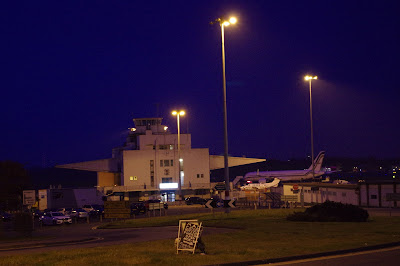Edith's entry for 10th March 1906 describes seeing birds with nesting materials and a variety of wildflowers. She was clearly very determined to find particular flowers and says:
I had to carry my cycle nearly a quarter of a mile down a steep, muddy fordrough set thick with thorns, with high banks on each side. On these sheltered banks I found numbers of small celandine blossom ...
If you were wondering, the
Topographical and Land-Use Terms page of John Morris Jones' site, tells us that fordrough means farm track. I am in awe of this young woman who, encumbered by long skirts and carrying a heavy Edwardian bicycle down a rough muddy track, explored and found the flowers she was looking for. My little walks have been far easier. This week I stayed at the
Crowne Plaza hotel from Tuesday the 8th to Thursday the 10th of March, which is at the edge of the Pendigo lake in the NEC complex.
 |
| Gorse and Traveller's Joy. |
I didn't have to go far to find my first wildflowers. There is a Gorse bush, smothered in its own yellow flowers and the fluffy seedheads of Traveller's Joy (clematis) just outside the hotel. The Traveller's Joy is particularly apt as it is a friendly and well-placed hotel. I found Colt's Foot flowers while walking round the South East edge of Pendigo lake. This was first thing in the morning on Wednesday the 9th of March, 110 years and 5 days after Edith recorded finding some while on "
a long walk".
 |
| Coots near the Crowne Plaza. |
Coming back to the hotel, I found a pair of cheeky Coots grazing the newly laid turf just outside, having taken over lawn mowing duties from the rabbits that were there the previous night.
 |
| Sky Walk - close to the site of the former Pendigo buildings. |
In Edith's time, the area was already associated with the name Pendigo. However it was a cluster of buildings, presumably a farm, rather than the lake that is there today. The buildings were roughly where NEC hall 5 is now, just south of the Sky Walk. Hall 5 is one of the halls being used for Crufts this year.
 |
| While I was staying at the Crowne Plaza, the NEC was preparing for Crufts. |
My Thursday morning walk to the office was enlivened by trails of dogs, from stumpy bulldogs to tiny Chihuahuas converging on the NEC. In 1906, when Edith wrote her diary,
Crufts had been running for 15 years under Charles Cruft and was held in Islington. The best champion (the forerunner of
Best in Show) was a Scotch Collie called Wishaw Leader. Both Crufts and Pendigo have come a long way since then.









